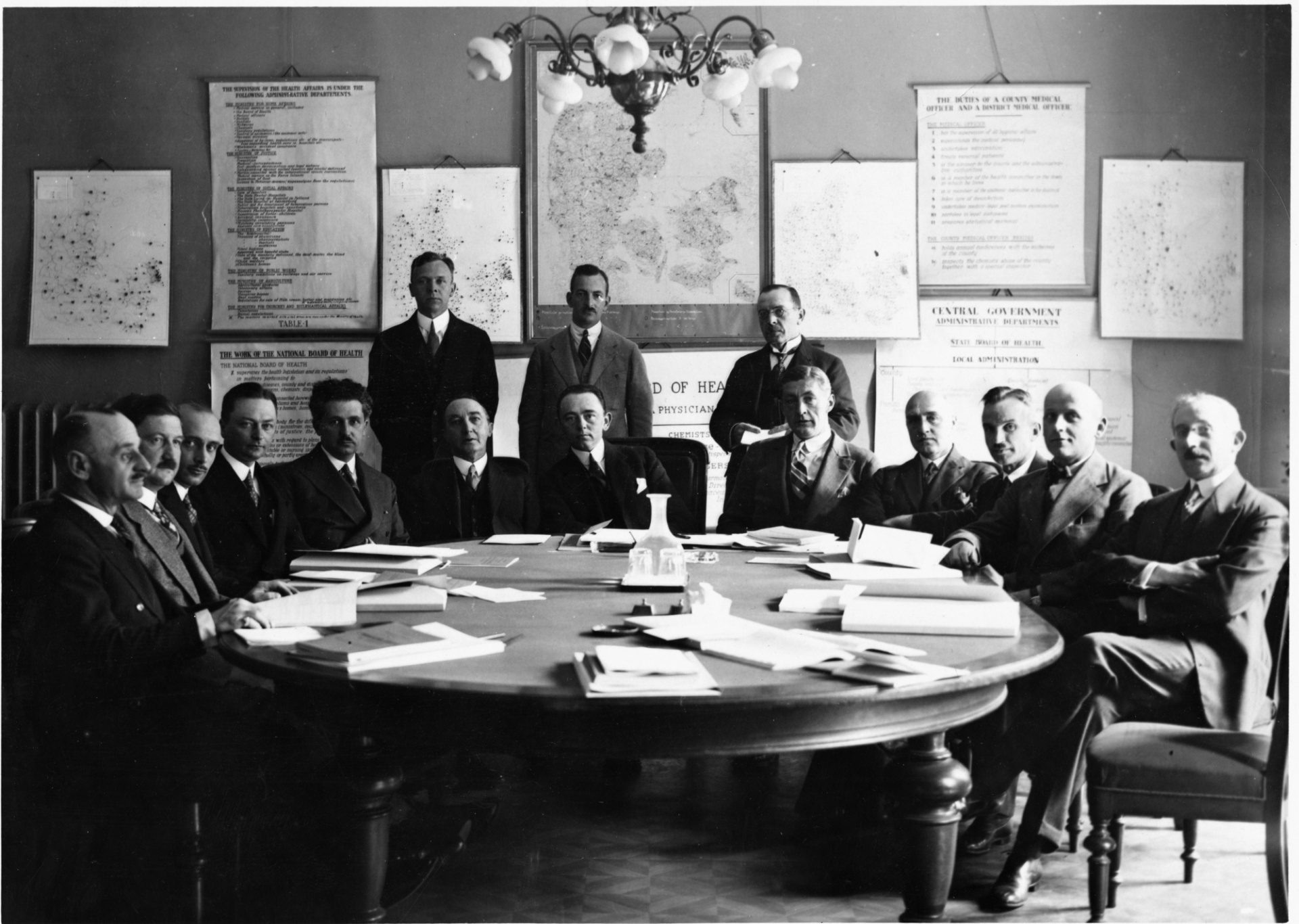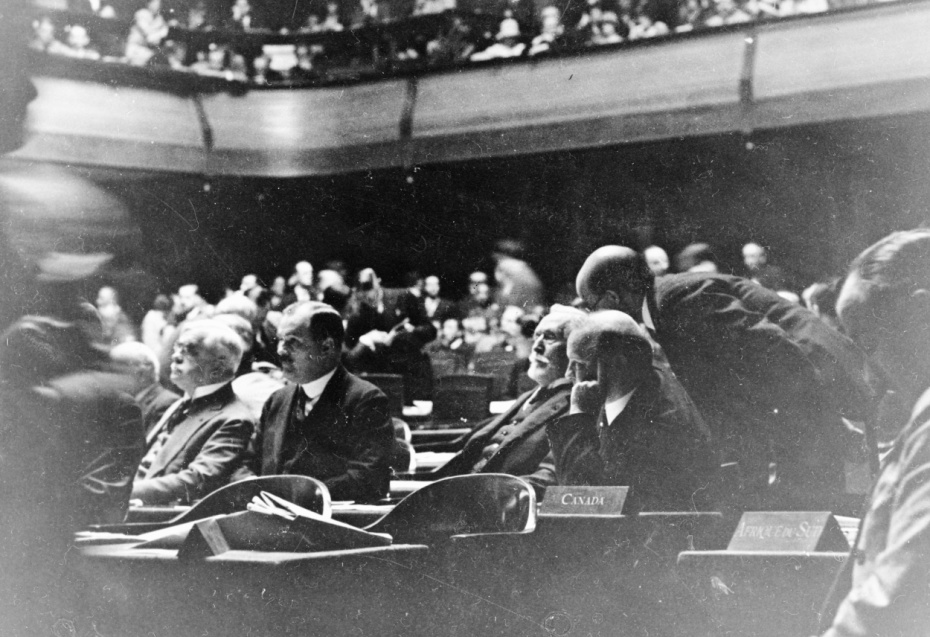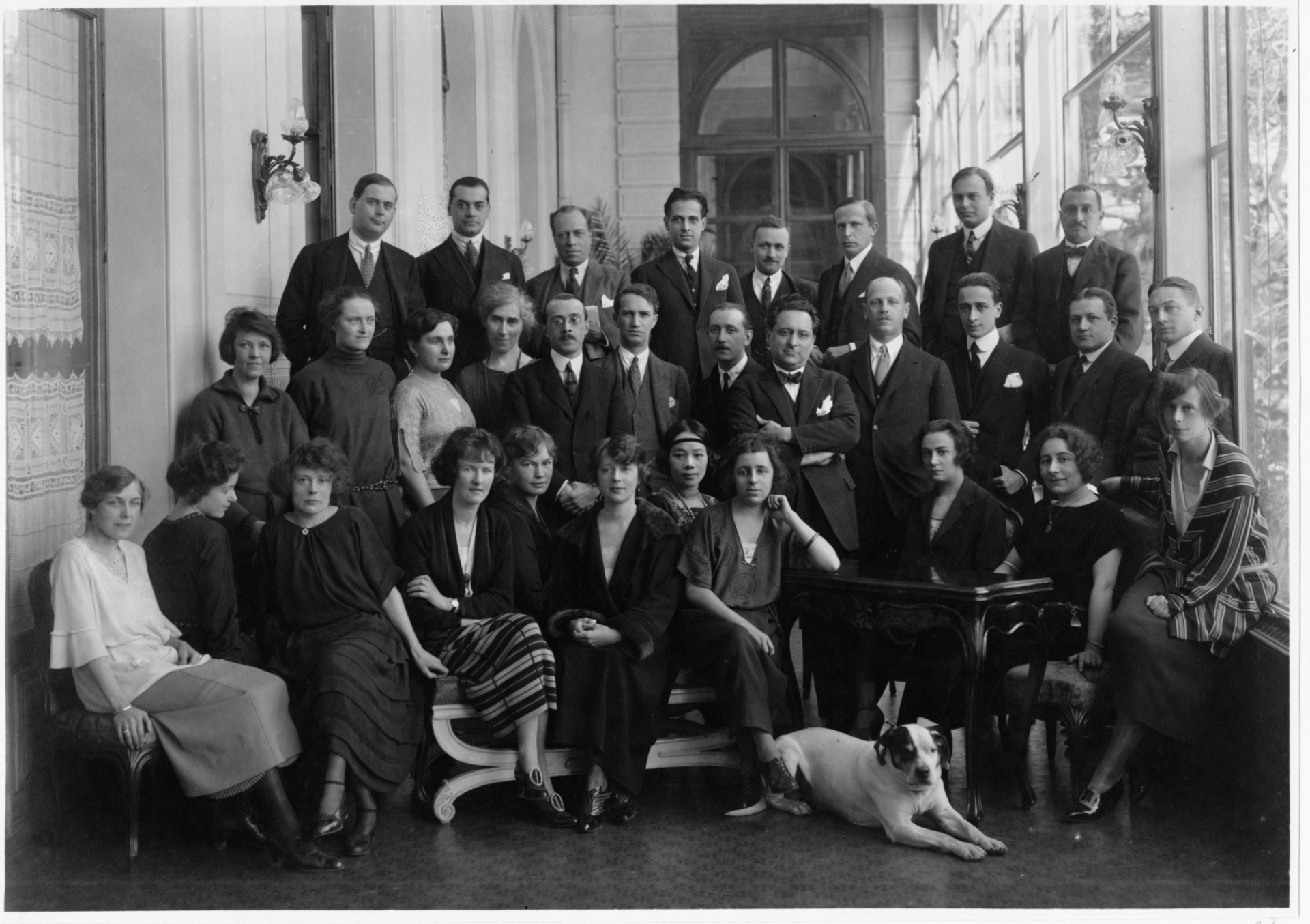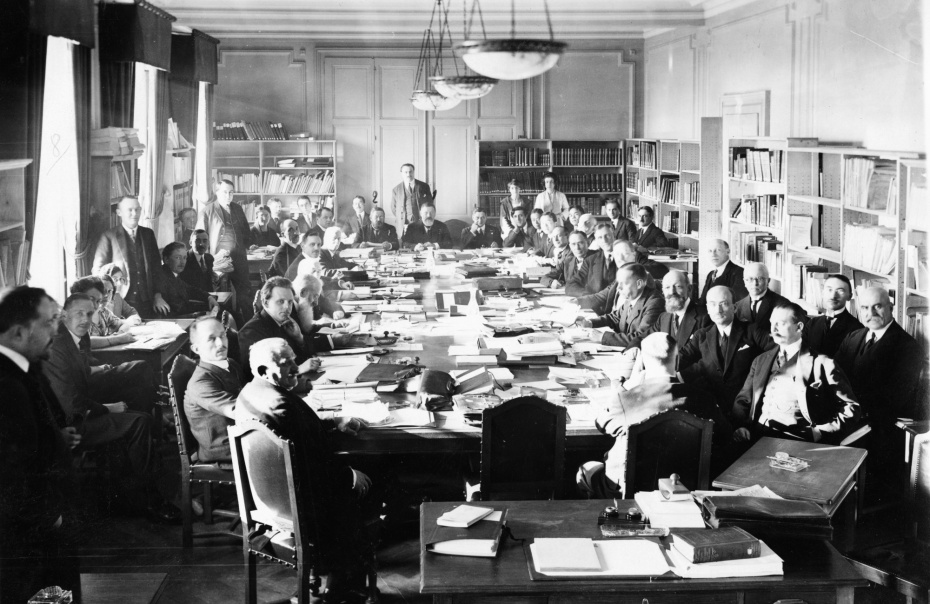
Breadcrumb
The Assembly
The Assembly was the main representative body of the League of Nations. It consisted of delegates of all Member States, which were equally represented: every State had one vote, without geographic, demographic or economic distinction.
The functions of the Assembly were very broad. According to the Covenant, it could deal with “any matter within the sphere of action of the League affecting the peace of the world”. Besides these general functions, the Assembly had also specific competences. For instance, it was in charge of approving the admission of new members and of amending the Covenant. The Assembly also adopted the budget of the League, which was financed by all the Member States according to their economic and financial position.
The decisions of the Assembly were based on the unanimity rule: Except where explicitly provided for in the Covenant, all decisions required the agreement of all Member States present at the meeting.
In Session
The Assembly met at least once a year in ordinary session, normally in September. If necessary, it could meet at any moment at the request of one or more members if approved by the majority of Member States. This happened for example in 1926, when Germany applied for admission to the League.
The delegates always met in Geneva. Before the construction of the Palais des Nations, the sessions were held in two different buildings located downtown: the Salle de la Réformation (from 1920 to 1929) and the Bâtiment électoral (from 1930 to 1936). Some extraordinary sessions took place in the Pavillon du désarmement, a building adjacent to the first headquarters building of the League in Geneva, today known as Palais Wilson. The Assembly started gathering at the Palais des Nations in 1937.
All voices are heard
The Assembly of the League of Nations was unprecedented: It gave, for the first time, small and medium states the opportunity to make their voices heard on global issues and to participate in diplomatic discussions on a regular basis. The meetings were open to the public and the press. At that time, this was very innovative.
Delegates could make their statements in any language, provided that they submitted a translation of their speech in French or English, the two official languages of the League. In the 1930s, a telephonic interpretation system was installed in the Assembly Hall. It allowed the delegates to listen to the interpretation simultaneously to the original speech.
The Council
Like the Assembly, the Council dealt with any question coming within the sphere of action of the League or affecting world peace. In this regard, the Assembly and the Council had similar competences. The two organs were to work in parallel, following up on issues brought up by the Member States. However, the Council also had special functions: For instance, it formulated plans for the reduction of armaments and was in charge of all questions concerning the territories under mandate. Some international treaties also conferred special functions to the Council, such as the supervision of the Free City of Danzig, minority treaties or the administration of the Saar Territory.
The Council consisted of permanent and non-permanent members. In 1920, the four permanent members were the British Empire, France, Italy, and Japan. The non-permanent members were elected by the Assembly for a three-year term. The composition of the Council varied over time. When it first met on 16 December 1920, there were four non-permanent members. However, their number increased in the following years to 6 in 1922, 9 in 1926, 10 in 1933, and 11 in 1936.
The logic behind the limited representation of the Council and the presence of major powers was to ensure quick and effective decision-making. The Council normally met three to four times per year, but it could be summoned at any time by the Secretary-General at the request of any Member State.
Decisions were taken by unanimity. This rule was introduced to respect the sovereignty of Member States. The League of Nations was not intended to be a “supra-national” organization. It was designed as a space of conciliation and compromise.
The meetings of the Council could be public or private (i.e., limited to delegates). In both cases, the minutes of the proceedings were published. This transparency of the work of the Council also applied to the Assembly and was considered a key element of the principle of open diplomacy contained in the Covenant. This meant that journalists and the public could attend the meetings.
The Secretariat
The Secretariat was the administrative organ of the League of Nations. It was composed of international civil servants headed by a Secretary-General. The Secretariat was temporarily established in London before moving to its headquarters in Geneva. It was first located in the Hotel National (a building known today as the Palais Wilson) from 1920 to 1936 and in the Palais des Nations from 1936 to 1946.
The Secretariat was in charge of preparing the work of the different bodies, overseeing the smooth running of meetings, and following up on decisions taken by Member States. Among its functions, the Secretariat also collected and published all the treaties signed by the Member States to ensure the transparency of international diplomacy.
The establishment of an international Secretariat was considered one of the most innovative aspects of the League. The officials of the Secretariat were responsible to the Secretary-General and could not seek or receive instructions from any government. From 1932, officials made a declaration of loyalty to the League. The Covenant also specified that all positions in the Secretariat were “open equally to men and women”. This pioneering provision was adopted thanks to the lobbying efforts of feminist groups during the Paris Peace Conference.
The Secretary-General was the chief of the League of Nations. He was responsible for the general direction of the work of the Secretariat. He appointed and removed all officials of the Secretariat (subject to the approval of the Council). In the event of a crisis, the Secretary-General could summon a meeting of the Council, and, in cases of dispute, he communicated with all parties to facilitate its examination or settlement.
The Secretaries-General of the League were Sir Eric Drummond (United Kingdom, 1920-1933), Joseph Avenol (France, 1933-1940) and Sean Lester (Ireland, 1940-1946).
Auxiliary organizations of the League
The League was also composed of subsidiary bodies which were created by the Covenant or established by the Assembly and the Council. These entities – called “organizations”, “commissions”, “institutes”, or “committees” – prepared the work of the principal organs and, in some cases, provided advice on specific matters.
The composition of the committees and commissions and the number of their members varied according to their mandate. Some, like the Permanent Advisory Commission for Military, Naval and Air Questions consisted of military experts appointed by the governments concerned. Others, like the Permanent Mandates Commission, were composed of experts appointed for their qualifications, irrespective of their nationality.
In addition, the League of Nations established technical organizations to facilitate international cooperation in specific fields. Among these organizations were the Economic and Financial Organization, the Communication and Transit Organization, the Health Organization, and the Intellectual Cooperation Organization. All of them played an important role and, in some cases, paved the way for the creation of UN Agencies, Funds and Programmes.
As Cordell Hull, US Secretary of State, noted in 1939: “the League of Nations has been responsible for the development of mutual exchange and discussions of ideas and methods to a greater extent and in more fields of humanitarian and scientific endeavour than any organization in history.”

Other organizations associated with the League
The International Labour Organization (ILO) and the Permanent Court of International Justice (PCIJ) were both independent from the League of Nations, although their budget was incorporated in the general budget of the League and adopted by the Assembly.
The International Labour Organization (ILO)
Like the League of Nations, the ILO was established at the Paris Peace Conference in 1919 on the basis that “universal and lasting peace can be established only if it is based upon social justice”. Its main function was to frame and supervise the application of international rules concerning labor conditions. The main organs of the ILO were the Governing Body, the “Conference”, and the International Labour Office (the ILO Secretariat). The particularity of the ILO was its so-called “tri-partite” representation. Contrary to the League of Nations, three categories of delegates were represented: governments, employers and employees (or, at that time, workers). The first Convention adopted by the ILO in 1919 limited the hours of work in industrial undertakings. Since then, its activities have continued without interruption, and the ILO became the first UN Specialized Agency in 1946.
The Permanent Court of International Justice (PCIJ)
The PCIJ was established by the League of Nations in 1921. It was located in the Hague, the Netherlands. The PCIJ was composed of 15 judges and could decide contentious cases on a state level by pronouncing judgements or giving advisory opinions. Its compulsory jurisdiction applied only to those States that accepted Article 36 of the Court’s Statute. The PCIJ delivered 32 judgments and 27 advisory opinions during its existence. The court officially ceased to exist in 1946. However, the Statute of the International Court of Justice (ICJ) – adopted together with the Charter of the United Nations at the San Francisco Conference in 1945 – reproduced the Statute of the PCIJ in almost identical form.



